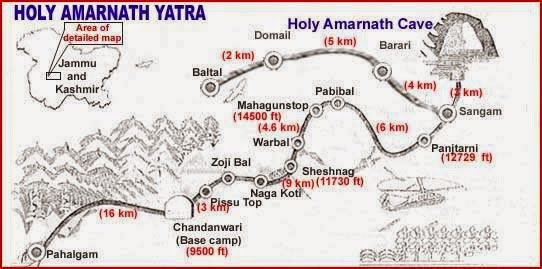Sri Amarnath Yatra which is being going from thousand years and as the dates for the pilgrimage to Sri Amarnath Yatra draws close, the environmentalists of Valley join hands to voice out the impact of mountain pilgrimage on the ecology and environment.
There are no doubts about the fact that it is our responsibility to express our concern for the deterioration in mountain ecology and environment, if any but sometimes things are not as they are portrayed.
Below are 5 facts that prove pilgrimage is not impacting the way rapid and unplanned urbanization, change in land use pattern and reckless usage of chemical fertilizer and pesticides in the agriculture and horticulture activities by the indigenous people:
-
It is an established fact that the to and fro moment of pilgrims is restricted strictly to the tracks between the road heads of Chandanwari and Baltal to the holy Amarnath Cave shrine. Not a single pilgrim is allowed to move beyond the width of the either tracks and as such the blame of degradation of environment ecology or biodiversity of the area by pilgrims is unfounded and biased. Same is true of Vashino Devi Yatra which is visited by about 80 to 90 lacks of pilgrims annually with practically no damage to ecology or environment.

-
The temporary and mobile population of tourists, with very brief stay in the valley for barely for 2 to 3 days, shall have very minimal impact on the environment compared to the impact caused by expanding and permanent native population of the valley. The scientific studies of Pohru and Doodhganga watersheds in the valley by the environmentalists substantiates to the above fact. According to the studies, about 48.27% of the area is under high erosion risk due to severe land degradation caused by loss of wetland, soil erosion and vegetation change.

-
The change in the land-use pattern by the indigenous people has seriously affected the major water bodies of the valley, such as Dal lake. The increase in the agriculture land, deforestation, increase in horticulture land, and built-up area has consequently added to the environmental degradation by way of excessive run-off of the eroded top-soil from mountain slopes and bare land surfaces and contribution of chemical fertilizers and pesticides to the water bodies rather than mountain pilgrimage in valley.
Watch Video| Click on the link: Do’s and Don’ts for Shri AmarnathJi Yatra

-
Hue and cry on glaciers are getting degraded. There are – five major glaciers around Amarnath namely Nehnar, Mushran, Thajwas and Sekhi in Sind valley and Koenjnar(Shushram) and Kolahi in Lidar valley but none of these glaciers are traversed by the Baltal, Pahalgam or Gulol Gali routes. However a small glacier lies besides the track between Vayurjana (Vowjan) pass and Panjtarangini (Panjtarni) even which does not lie across the track. Many of these snow accumulations and snow bridges have been confused with glaciers even in places like Chandanwari and all along the Baltal route.

-
There is no denial to the fact that tourism in J & K state has been on decline as a consequence of the continuous turmoil in the state. The J & K Economic Survey 2016 categorically voices the deteriorating state of tourism. The tourist inflow declined from 95.25 lakh in 2014 to 92.03 lakh in 2015. Further break up confirms that the inflow of tourist in Jammu region was substantially more than other regions of the state. Out of 12.81 lakh tourists’ inflow in Kashmir region in 2015 and 15.41 lakh inflows of tourists in Kashmir region in 2014, the pilgrim tourists were only 3.53 lakh in 2015 and 3.73 lakh in 2014. The pilgrim tourist inflow to Kashmir region therefore formed ~ 25% of the total tourist inflow for the years 2014 and 2015. The J & K Economic Survey 2016 identifies the pilgrim tourist as “short duration tourist” with a stay in the valley for barely 2 to 3 days.

Any change in one component of the environment is bound to have impact on other component/s, as environment is holocoenotic in nature.
Now that you know of these, make others aware!


